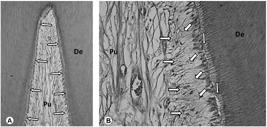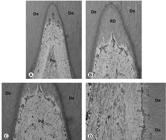This study evaluated a whitening effect and the likely side effect (tooth sensitivity and pulp response) of human teeth subjected to different in-office bleaching (IOB) techniques and materials, mainly the presence of calcium in the IOB materials. A calcium-free (CF) and a calcium-containing (CC) 35% hydrogen peroxide (HP) gels were evaluated. The CF was refreshed every 15 minutes, three times (CF 3-15) or in a single 45-min application (CF 1-45) at one bleaching appointment. The CC was used only in a single 45-min application (CC 1-45). Each technique was applied in 5 mandibular incisors scheduled for extraction for different patients. In control group, no tooth bleaching was performed. The tooth colour (TC) and tooth sensitivity (TS) were recorded at baseline and after IOB. The teeth were extracted 2 days after the application of IOB and subjected to histological analysis. The data was submitted to appropriate statistical analysis (α=0.05). The changes of TC were similar between groups and statistically different from the control (p<0.05). However, TS of groups bleached with CF was statistically higher than that recorded for CC and the control (p<0.05). In CF 3-15 and CF 1-45 groups, the coronal pulp tissue exhibited partial necrosis associated with tertiary dentin deposition. In CC 1-45 group smaller area of necrosis occurred only in three bleached teeth in which tertiary dentin deposition was observed. The calcium-containing 35%HP gel could be preferable for in-office bleaching because it caused less tooth sensibility and pulp damage.
Tooth bleaching; hydrogen peroxide; materials testing; metabolism

 Thumbnail
Thumbnail
 Thumbnail
Thumbnail
 Thumbnail
Thumbnail




